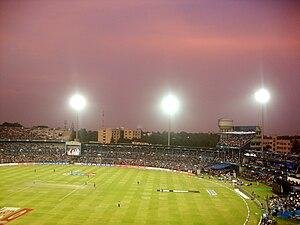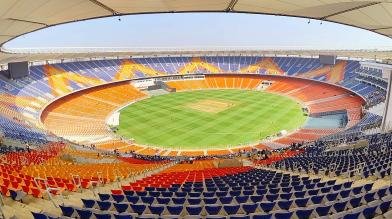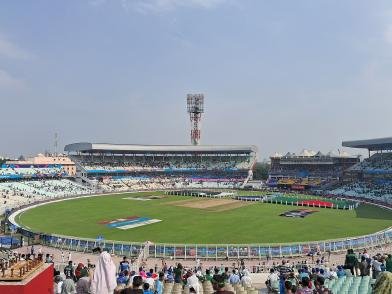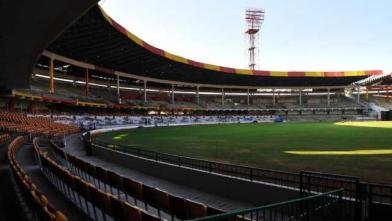The Historic Fortress of Cuttack
Barabati Stadium, located in Cuttack, Odisha, is one of the oldest and most iconic cricket venues in India, established in 1958. With a seating capacity of nearly 45,000 spectators, it has been the stage for historic Tests, ODIs, T20Is, and World Cup matches. Known for its slow, turning pitches, the stadium is often called a “spinner’s paradise,” testing batters’ patience and technique.
Legends such as Kapil Dev, Anil Kumble, MS Dhoni, and Virat Kohli have created unforgettable moments here, adding to its legacy. Beyond cricket, Barabati is also a hub for football tournaments, political rallies, cultural festivals, and concerts, making it a multi-purpose landmark of Odisha. Surrounded by the Mahanadi River and the historic Barabati Fort, the venue is both a sporting destination and a cultural symbol of the region.
📍 Location & Accessibility
Barabati Stadium is located in the cultural capital of Odisha – Cuttack, just a few kilometers from the banks of the Mahanadi River and near the historic Barabati Fort. Its central location makes it easily accessible from Bhubaneswar (about 30 km away), connected via NH-16 and Biju Patnaik International Airport. For fans and tourists, the stadium is surrounded by hotels, eateries, and iconic landmarks, making it a convenient cricketing destination.
🏏 Historical Background
Established in 1958, Barabati Stadium is among the oldest cricket grounds in India. It was built by the Odisha Cricket Association (OCA) to promote cricket in the eastern region of India. Over the decades, it has evolved from a modest venue into a full-fledged international stadium, hosting Test matches, ODIs, T20Is, and IPL games.
The stadium has been home to the Odisha cricket team in domestic tournaments such as the Ranji Trophy, Vijay Hazare Trophy, and Syed Mushtaq Ali Trophy. It has nurtured numerous local talents and played a vital role in taking Odisha cricket to the national stage.
🌟 Architectural Features & Infrastructure
Barabati Stadium is known for its traditional design combined with modern upgrades.
- Seating Capacity: ~45,000 spectators
- Stands & Galleries: Open galleries and covered stands with a panoramic view of the ground.
- Floodlights: Installed in 1997, making it one of the earliest Indian stadiums ready for day-night matches.
- Pavilions: Modern player pavilions with dressing rooms, medical facilities, and recovery areas.
- Press & Media Facilities: A dedicated press box and media center meeting international broadcasting standards.
- Practice Grounds: Equipped with turf nets and training facilities for both home and visiting teams.
- VIP Lounges: Corporate boxes and air-conditioned lounges for dignitaries and sponsors.
The stadium has been renovated multiple times, especially before hosting international matches, to maintain ICC standards.
🏏 Cricketing Legacy
Barabati Stadium has witnessed many iconic cricketing moments:
- First International Match: ODI between India and England on 27 January 1982.
- First Test Match: India vs Sri Lanka in January 1987.
- ODI Legacy: Known for hosting low-scoring thrillers due to its slow pitch and turning conditions.
- Memorable Innings:
- MS Dhoni’s explosive 51-ball 91 against Sri Lanka in 2014.
- Kapil Dev’s fiery spells during the 1980s.
- Anil Kumble and Harbhajan Singh’s spin dominance in Tests.
- T20 Internationals: Hosted India vs South Africa T20I in 2015, where fans witnessed a packed crowd and lively atmosphere.
🌍 Pitch Report & Playing Conditions
The Barabati pitch is renowned for being slow and spin-friendly.
- Nature of Pitch: Dry surface, offering low bounce and turn.
- For Pacers: Early swing due to coastal humidity.
- For Spinners: Dominant in the middle overs and in longer formats.
- Batting Conditions: Challenging; batters need patience and technique.
- Dew Factor: Influences day-night ODIs and T20s, favoring teams batting second.
Format-Wise Behavior:
- T20Is: Average score: 140–160; chasing preferred.
- ODIs: Average first innings score: 250–270; spin plays a crucial role.
- Tests: Becomes tougher to bat after Day 3; spinners dominate.
🎉 Major Tournaments & Events
- International Matches: Hosted several Tests, ODIs, and T20Is involving teams like England, West Indies, Sri Lanka, and South Africa.
- ODI World Cup Venue: Was one of the venues for the 1987 Cricket World Cup and the 1996 Cricket World Cup.
- IPL Matches: Served as a home ground for Delhi Daredevils (Delhi Capitals) in 2010 & hosted Kolkata Knight Riders (KKR) matches.
- Domestic Tournaments: Regular host for Ranji Trophy, Duleep Trophy, and Deodhar Trophy matches.
- Other Sports: Hosted Santosh Trophy football matches and athletic meets.
🎭 Beyond Cricket – Cultural Importance
Barabati Stadium is not limited to sports:
- Hosted political rallies by national leaders.
- Venue for concerts and cultural festivals, celebrating Odisha’s heritage.
- Used for community gatherings and large-scale events, making it a landmark beyond cricket.
🙌 Fan Experience & Atmosphere
One of Barabati Stadium’s strongest aspects is its fans. The people of Odisha are known for their cricket passion and knowledge, often turning matches into carnivals. The roar of 45,000+ spectators creates an electric atmosphere that players cherish.
Nearby attractions include:
- Barabati Fort – a historic 14th-century structure.
- Netaji Birth Place Museum – dedicated to Subhas Chandra Bose.
- Mahanadi River banks – a scenic retreat for visitors.
Fans often club cricket matches with sightseeing, making Cuttack a unique cricket-tourism hub.
📊 Records & Statistics at Barabati Stadium
- First ODI: India vs England, 1982.
- First Test: India vs Sri Lanka, 1987.
- Highest ODI Team Score: India – 363/5 vs Sri Lanka (2014).
- Lowest ODI Score: Sri Lanka – 123 all out vs India (1994).
- Top ODI Scorers at Venue: MS Dhoni, Sachin Tendulkar, Virat Kohli.
- Top Wicket-Takers: Anil Kumble, Harbhajan Singh, Ajit Agarkar.
🏏 Barabati Stadium in the IPL
Though not a permanent IPL ground, Barabati Stadium has hosted:
- Delhi Daredevils (Delhi Capitals) home matches in IPL 2010.
- Kolkata Knight Riders (KKR) fixtures in earlier seasons.
Fans in Odisha received IPL with unmatched enthusiasm, and the venue is often considered a backup ground for franchises.
📌 Conclusion
Barabati Stadium is not just a sporting venue; it’s a symbol of Odisha’s sporting spirit and India’s cricketing heritage. With its rich history, challenging pitch, electrifying fans, and cultural importance, it continues to hold a special place in Indian cricket.
From hosting World Cups to IPL encounters, Barabati remains a stadium where history meets passion.






